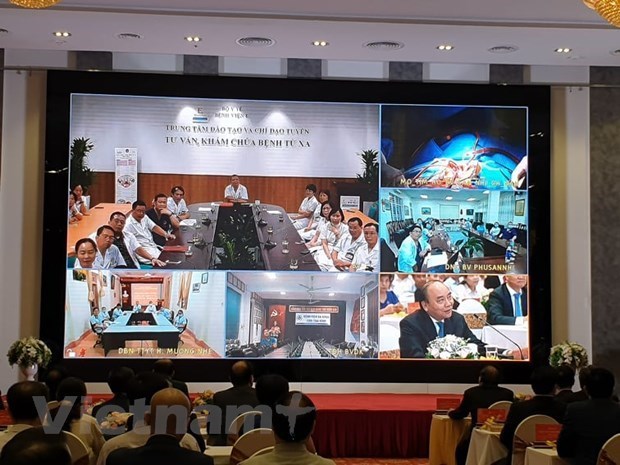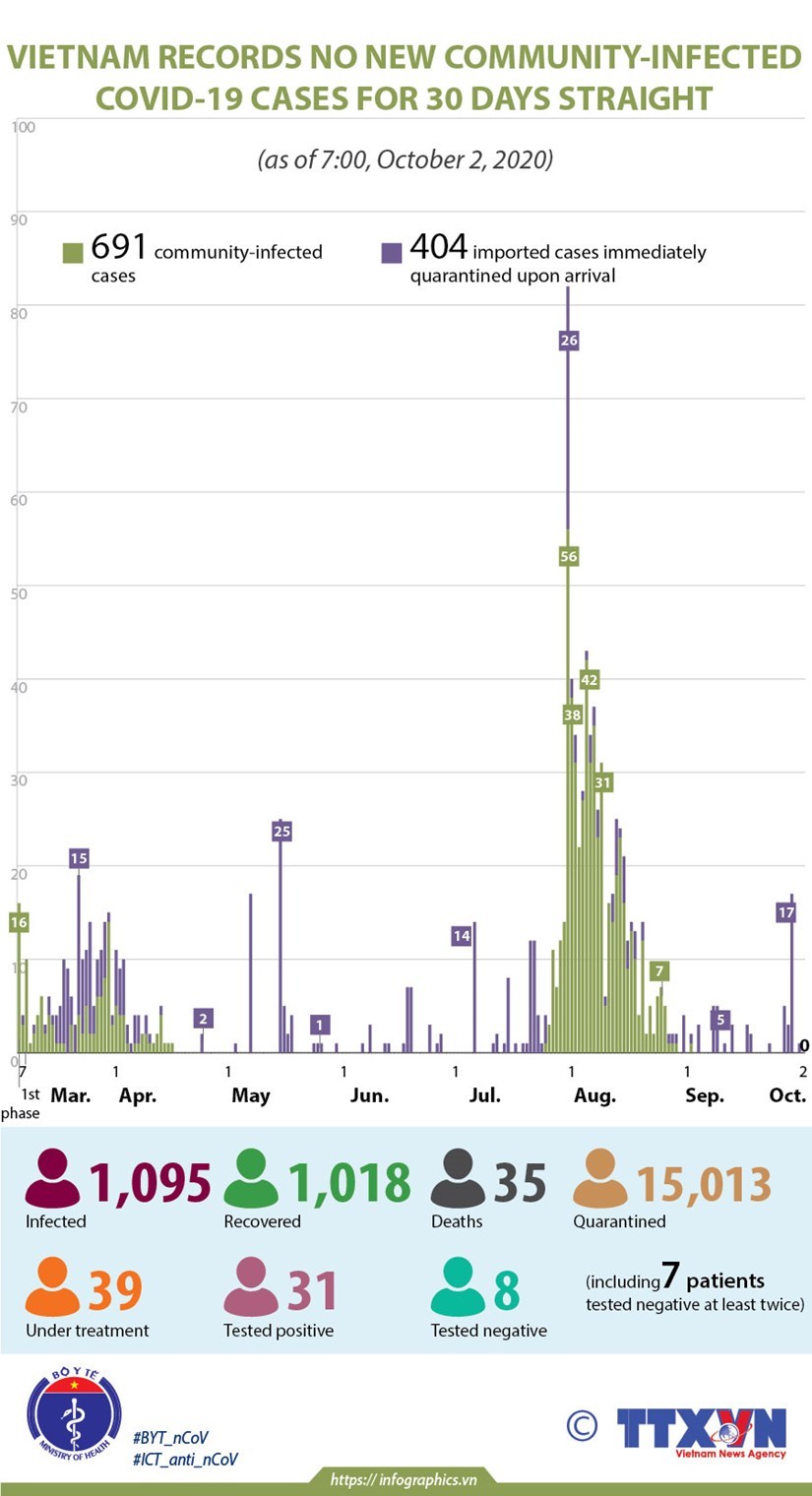 |
|
The health sector is stepping up the application of technology in telehealth checks-up and treatment
|
Speaking at the event, Dam and said the World Health Organisation (WHO) forecast that the pandemic could last until the end of 2021 due to the unavailability of vaccines.
With the Party’s sound leadership, the PM and Government’s determination, and the close collaboration between the steering committee and ministries, agencies and localities, Vietnam effectively and promptly localised affected areas, helping to achieve the dual goal of fighting the pandemic and ensuring economic growth.
The country also stepped up cooperation with foreign experts and organisations to study the novel coronavirus SARS-CoV-2, share treatment therapies and offer mutual support, he said.
After four COVID-19 transmission risks were defined in Vietnam, the map of safe living with COVID-19 www.antoancovid.vn was launched on October 1, which will be firstly used at schools and medical establishments to update information about the disease.
Later, the map will be widely used in lodging facilities, offices, factories, supermarkets and public transport vehicles.
The Ministry of Health is working closely with the Ministry of Science and Technology and the Ministry of Information and Communications to complete the tool.
The Deputy PM asked the Ministry of Health to work on the national electronic health records to monitor the health of the elderly, patients with outlying diseases and those at high risk of COVID-19 infection, as well as step up remote health check-ups and treatment.
Acting Minister of Health Nguyen Thanh Long said Vietnam experienced two waves of COVID-19 outbreaks in March and July with 1,096 infections and 35 deaths. The country has so far gone through 30 consecutive days without local transmissions and 1,020 patients have been given the all-clear from the virus.
As the upcoming winter-spring climate is conducive to the spread of the virus, he urged localities and people to stay vigilant, especially closely controlling illegal entry at border gates.
Deputy Minister of National Defence Sen. Lieut. Gen Tran Don directed units and localities to ensure security and order, keep track of entries to Vietnam to minimise transmission risks in the community./.
Localities share experience in battling COVID-19
The Ministry of Health held a teleconference recently discussing measures to ensure safety in battling COVID-19 at medical facilities, with more than 700 units around the country participating.
The teleconference reviewed lessons in COVID-19 treatment and measures to contain the spread of this and other acute respiratory diseases in hospitals.
In his opening remarks, Deputy Minister of Health Nguyen Truong Son underlined that in addition to quarantining people that visited pandemic-hit regions, early detection and appropriate treatment have an important role to play in coping with the disease.
The ministry has prepared guidelines on COVID-19 diagnoses and treatment at hospitals, with updates from previous outbreaks and the experience of others.
Notably, the establishment of a centre providing online consultations has contributed to saving critical COVID-19 patients and raising treatment quality.
The pandemic has broken out in 215 countries and territories worldwide, Son noted. More than 34 million people have been infected with the novel coronavirus SARS-CoV-2, which causes COVID-19, while over 1 million have died.
Vietnam has so far reported 1,095 cases, of which 1,018 have now been given the all-clear, for a recovery rate of 96.4 percent. The country has also recorded 35 fatalities.
A total of 54 medical facilities around the country have provided treatment to COVID-19 patients. Thirty-two patients are now being treated at nine hospitals.
Vietnam records no new COVID-19 cases on Oct. 3 morning
Vietnam recorded no new COVID-19 cases on October 3 morning, marking 31 consecutive days without infections in the community.
The country has to date confirmed 1,096 COVID-19 cases, including 691 local infections and the remainders are imported cases, according to the National Steering Committee for COVID-19 Prevention and Control.
Among the patients undergoing treatment, one has tested negative for the novel coronavirus SARS-CoV-2 once, two twice and four thrice.
As many as 1,020 patients were successfully treated and there are now no patients in critical conditions.
The death toll from the disease remained at 35, most of them were elderly people with serious underlying conditions.
A total of 16,182 people who had close contacts with COVID-19 patients or entered Vietnam from pandemic-hit regions are being quarantined across the county, including 723 in hospitals, 10,796 in concentrated quarantine establishments and 4,663 at their residences./.
CAJ highlights role of media during COVID-19 pandemic
The Confederation of ASEAN Journalists (CAJ) has highlighted the role of the media in the fight against COVID-19, saying “trust in the media is most crucial in time of crisis.”
It has been over 10 months that the COVID-19 pandemic has wreaked havoc on countries around the world. More than 33 million people have been affected, and unfortunately over a million people have died as a result. The pandemic is undoubtedly the biggest challenge facing the international community, the CAJ said in its statement issued recently.
“This challenge for countries in Southeast Asia is no less daunting, if not more. In an online informal meeting of members of the Confederation of ASEAN Journalists (CAJ) recently, we heard how governments and societies in their countries work together to battle the pandemic,” it said.
In order to express their concerns over the continuing pandemic and its economic and social impact and to demonstrate their solidarity with the governments and peoples in the ASEAN region in coping with the crisis, CAJ members issued a statement to recognise the ongoing efforts by governments and peoples of all the CAJ member countries to overcome the pandemic and its economic and social impact in their respective territories.
The CAJ appreciates all the hard work provided by healthcare workers whole have been at the frontline in battling the pandemic, and spirit of volunteerism by individual members of the public in this critical time has given us some shining moments in these dark hours.
As governments and societies join hand to combat the pandemic, the role of the media has become more crucial as ever, both in providing accurate information and keeping the public informed.
Most important of all, media practitioners are reminded that they must not let their guard down as far as professional ethnics is concerned in their coverage of the pandemic. Trust in the media is most crucial in time of crisis.
The CAJ strongly promotes transboundary cooperation among its member countries so that timely and valuable information on the pandemic can be shared. Equally important, CAJ member countries can learn from each other’s experience in fighting against the deadly disease.
Amidst the pandemic, the media, therefore, have responsibility to combat fake news and disinformation about the pandemic which has become a scourge that needs to be countered through joint efforts and cooperation among all the professional media in the region./.
Da Nang closes COVID-19 treatment hospital
The Steering Committee for COVID-19 Prevention and Control in the central city of Da Nang decided on October 2 to dissolve the Hoa Vang COVID-19 treatment hospital.
Located within the medical centre in Hoa Vang district, the hospital treated a total of 239 patients, with the last discharged on September 23.
The medical centre is to continue handling the remaining workload.
Da Nang was the pandemic epicentre of the second COVID-19 outbreak, which began on July 25.
As of the morning of October 2, the city had gone 33 consecutive days without any community transmissions and recorded no new cases for 31 days.
Over 350 Vietnamese citizens flown home from UK
More than 350 Vietnamese citizens were taken home from the UK on a flight arranged by Vietnamese authorities, the Vietnamese Embassy in the UK, Vietnam Airlines and British competent agencies on October 2 and 3.
The passengers included children aged under 18; students whose study completed, visas expired and or schools and dormitories closed; pregnant women; the elderly; the illnesses; and people who had been stranded during their travel or business trips.
The Vietnamese Embassy worked with the host country’s competent agencies to support the citizens in reaching the airport and sent staff to the airport to assist them with boarding procedures.
Vietnam Airlines strictly implemented in-flight security and disease prevention measures to prevent the spread of the novel coronavirus SARS-CoV-2.
Upon landing at the Van Don international airport in the northern province of Quang Ninh, all crewmembers and passengers were given heath checkups and put into compulsory quarantine in accordance with regulations.
In the future, more flights are set to be conducted to repatriate Vietnamese citizens with disadvantaged circumstances, depending on their need and quarantine capacity at home./.
 |
Thailand allows partial reopening of borders to tourists
Thai authorities said on October 2 that the country will begin reopening its borders to outsiders and kick-start the tourism industry plagued by the COVID-19 pandemic with a flight from China this month.
The scheme has been designed to forestall any risk of importing new cases, with only visitors from countries deemed low risk allowed to enter Thailand and all new arrivals required to spend 14 days in hotel quarantine.
According to a Tourism Authority of Thailand spokeswoman, the first arrivals will be a group of 150 Chinese tourists, with local media reporting that their flight would land on the resort island of Phuket next week.
If there are no problems with the first group, two more flights – one carrying Chinese passengers and another with European travellers – are booked to follow.
Prime Minister Prayut Chan-O-Cha told reporters this week that only a limited number of visitors would be allowed into Thailand, and that they would be monitored through wristbands and mobile phone apps.
Thailand’s economy is highly dependent on foreign visitors but the country is expecting a fraction of the nearly 40 million international arrivals it recorded last year, after the pandemic brought global air travel to a near standstill./.